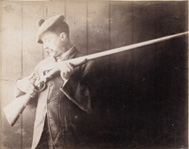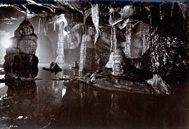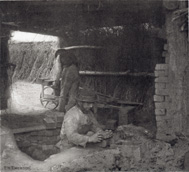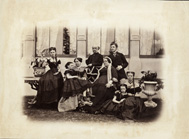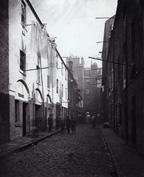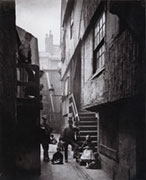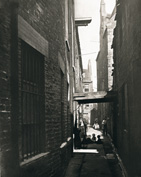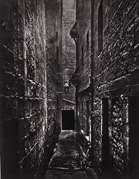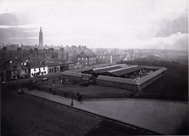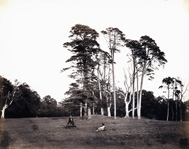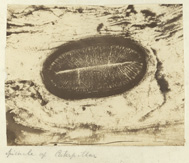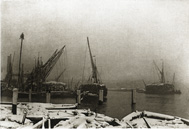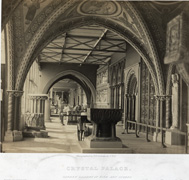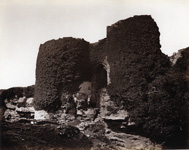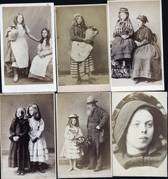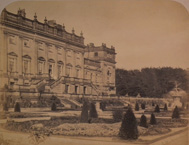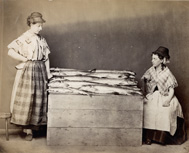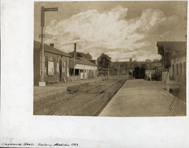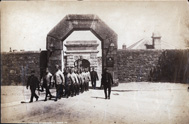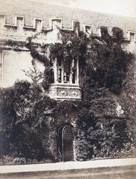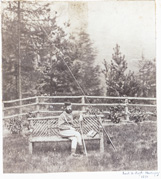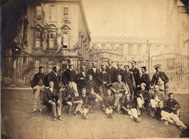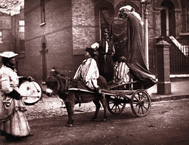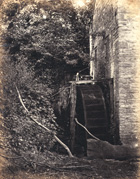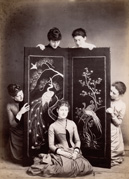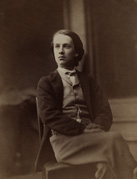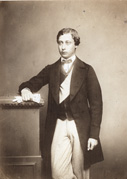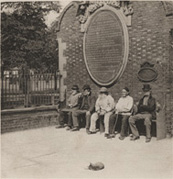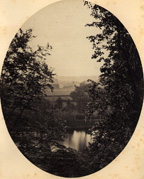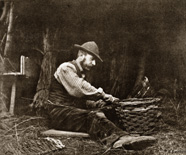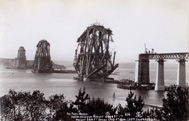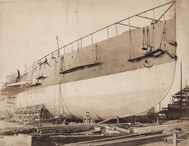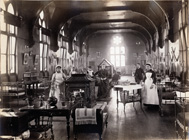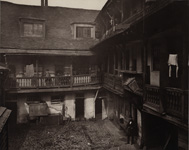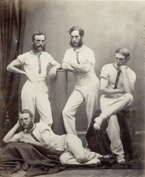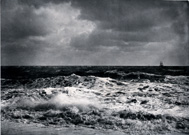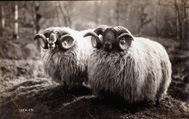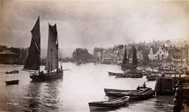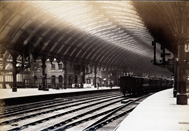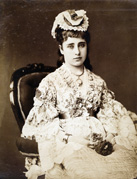"Self and 4- bore" rifle
Albumen print, c. 1880s
7/10, small edge tear but glued down; 125 x 157 mm, mounted
$275.
The quintessential big game rifle of the 19th century. Described below print as "Britannia - 8" - alkaline".
Albumen print, c. 1880s
7/10, small edge tear but glued down; 125 x 157 mm, mounted
$275.
The quintessential big game rifle of the 19th century. Described below print as "Britannia - 8" - alkaline".
'The Transformation Scene', Cox's Cave, Cheddar
Gelatin silver print, c. 1900
10/10; 142 x 206 mm, unmounted
$150.
Many inscriptions on verso including what look's like 'a Frith photo'.
Gelatin silver print, c. 1900
10/10; 142 x 206 mm, unmounted
$150.
Many inscriptions on verso including what look's like 'a Frith photo'.
Brickmaking
Photogravure, c. 1888
10/10; 177 x 195 mm
$750.
This photogravure is from Emerson's limited edition publication, 'Pictures of East Anglian Life', 1888.
Photogravure, c. 1888
10/10; 177 x 195 mm
$750.
This photogravure is from Emerson's limited edition publication, 'Pictures of East Anglian Life', 1888.
British family group
Albumen print, c. 1860
10/10; 142 x 189, mounted
$145.
Light folds on the print are visible only at an oblique angle (these were there before print was mounted on its period thin album page).
Albumen print, c. 1860
10/10; 142 x 189, mounted
$145.
Light folds on the print are visible only at an oblique angle (these were there before print was mounted on its period thin album page).
Broad Close, No. 167 High Street
Carbon print, 1870s
Tonality- 10/10, some original retouching; 282 x 232 mm., on printed mount
$1750.
Between 1868 and 1871, Annan produced a series of commissioned photographs for the City of Glasgow to document slum areas listed for demolition. Annan's carbon prints, published in 1877, very much suited their dramatic sombre subjects and transcended a mere record of the old buildings. 'However inadvertently, he did give us the first thorough photographic representation available of the dwelling places and inhabitants of an urban slum.' (Anita Mozley, 1977).
Carbon print, 1870s
Tonality- 10/10, some original retouching; 282 x 232 mm., on printed mount
$1750.
Between 1868 and 1871, Annan produced a series of commissioned photographs for the City of Glasgow to document slum areas listed for demolition. Annan's carbon prints, published in 1877, very much suited their dramatic sombre subjects and transcended a mere record of the old buildings. 'However inadvertently, he did give us the first thorough photographic representation available of the dwelling places and inhabitants of an urban slum.' (Anita Mozley, 1977).
Close, No 28 Saltmarket, Glasgow
Carbon print, c. 1868
Tonality- 10/10, some original retouching; 278 x 224 mm., mounted
$SOLD
Between 1868 and 1871, Annan produced a series of commissioned photographs for the City of Glasgow to document slum areas listed for demolition. Annan's carbon prints, published in 1877, very much suited their dramatic sombre subjects and transcended a mere record of the old buildings. 'However inadvertently, he did give us the first thorough photographic representation available of the dwelling places and inhabitants of an urban slum.' (Anita Mozley, 1977).
Carbon print, c. 1868
Tonality- 10/10, some original retouching; 278 x 224 mm., mounted
$SOLD
Between 1868 and 1871, Annan produced a series of commissioned photographs for the City of Glasgow to document slum areas listed for demolition. Annan's carbon prints, published in 1877, very much suited their dramatic sombre subjects and transcended a mere record of the old buildings. 'However inadvertently, he did give us the first thorough photographic representation available of the dwelling places and inhabitants of an urban slum.' (Anita Mozley, 1977).
Close, No. 29 Gallowgate
Photogravure, 1868
Tonality- 10/10; 222 x 177 mm., printed on paper sheet
$385.
This photogravure was printed by Thomas Annan's son, J. Craig Annan, in a limited edition in 1900 from the 1868 negative. Between 1868 and 1871, Thomas Annan had produced a series of commissioned photographs for the City of Glasgow to document slum areas listed for demolition.
Photogravure, 1868
Tonality- 10/10; 222 x 177 mm., printed on paper sheet
$385.
This photogravure was printed by Thomas Annan's son, J. Craig Annan, in a limited edition in 1900 from the 1868 negative. Between 1868 and 1871, Thomas Annan had produced a series of commissioned photographs for the City of Glasgow to document slum areas listed for demolition.
Close, No. 61 Saltmarket, Glasgow
Carbon print, c. 1868
10/10; 259 x 201 mm, mounted
$SOLD
Atypically, there are no people visible in this Annan documentary study. Nevertheless, the viewer is left in little doubt what conditions were like for local residents in what constitutes one of the bleakest photographs from the 19th century. In the 1900 photogravure edition of this work, published by Annan's son James Craig Annan, the plate was retouched to considerably lighten the 'black hole'. The effect was to considerably alter the dark mood seen here in the original.
Carbon print, c. 1868
10/10; 259 x 201 mm, mounted
$SOLD
Atypically, there are no people visible in this Annan documentary study. Nevertheless, the viewer is left in little doubt what conditions were like for local residents in what constitutes one of the bleakest photographs from the 19th century. In the 1900 photogravure edition of this work, published by Annan's son James Craig Annan, the plate was retouched to considerably lighten the 'black hole'. The effect was to considerably alter the dark mood seen here in the original.
Clothes Market, foot of Saltmarket
Carbon print, c. 1868
10/10; 222 x 307 mm, mounted
$2000.
Between 1868 and 1871, Annan produced a series of commissioned photographs for the City of Glasgow to document slum areas listed for demolition. Annan's carbon prints, published in 1877, very much suited their dramatic sombre subjects and transcended a mere record of the old buildings. 'However inadvertently, he did give us the first thorough photographic representation available of the dwelling places and inhabitants of an urban slum.' (Anita Mozley, 1977).
Carbon print, c. 1868
10/10; 222 x 307 mm, mounted
$2000.
Between 1868 and 1871, Annan produced a series of commissioned photographs for the City of Glasgow to document slum areas listed for demolition. Annan's carbon prints, published in 1877, very much suited their dramatic sombre subjects and transcended a mere record of the old buildings. 'However inadvertently, he did give us the first thorough photographic representation available of the dwelling places and inhabitants of an urban slum.' (Anita Mozley, 1977).
Couple posed in front of trees
Albumen print, c. 1858
9/10; 197 x 250 mm, unmounted
$1000.
Morgan was based in Clifton, now a part of Bristol, and exhibited extensively at British photographic exhibitions between 1856 and 1865. His subjects were often landscapes of nearby scenes in England and Wales. His photographs are very scarce.
Albumen print, c. 1858
9/10; 197 x 250 mm, unmounted
$1000.
Morgan was based in Clifton, now a part of Bristol, and exhibited extensively at British photographic exhibitions between 1856 and 1865. His subjects were often landscapes of nearby scenes in England and Wales. His photographs are very scarce.
Detail of caterpillar, photomicrograph
Salt print, c. 1850s
8/10; 94 x 122 mm, mounted
$SOLD
The provenance for this photograph is an auction that also contained rare early Tripe views of the West Country in England which are less well known than his esteemed photographs of India and Burma. Tripe is known to have probably produced photomicrographs but the details are unclear.
Salt print, c. 1850s
8/10; 94 x 122 mm, mounted
$SOLD
The provenance for this photograph is an auction that also contained rare early Tripe views of the West Country in England which are less well known than his esteemed photographs of India and Burma. Tripe is known to have probably produced photomicrographs but the details are unclear.
Foggy day on the Thames
Photogravure, c. 1889
10/10; 119 x 175 mm
$475.
According to Gernsheim (Creative Photography, 1962), Gale was part of a group of new landscape photographers who emerged in the style of P.H. Emerson. This print was published in Sun Artists, said to be the first book to present photography as a fine art (many years before Camera Work). The Art Journal called the publication: 'The high water mark of modern photography'. Gale was a founding member of the Linked Ring in Britain.
Photogravure, c. 1889
10/10; 119 x 175 mm
$475.
According to Gernsheim (Creative Photography, 1962), Gale was part of a group of new landscape photographers who emerged in the style of P.H. Emerson. This print was published in Sun Artists, said to be the first book to present photography as a fine art (many years before Camera Work). The Art Journal called the publication: 'The high water mark of modern photography'. Gale was a founding member of the Linked Ring in Britain.
Garden Gallery of Fine Art Courts, Crystal Palace
Albumen print, c. 1859
7/10; 191 x 242 mm, mounted on printed sheet
$SOLD
Delamotte taught drawing at King's College, London but also became one of the most important early British photographers and wrote a technical manual on photography. He made a celebrated series of photographs of the construction of the second Crystal Palace at Sydenham and later another of the finished galleries (of which this print is part).
Albumen print, c. 1859
7/10; 191 x 242 mm, mounted on printed sheet
$SOLD
Delamotte taught drawing at King's College, London but also became one of the most important early British photographers and wrote a technical manual on photography. He made a celebrated series of photographs of the construction of the second Crystal Palace at Sydenham and later another of the finished galleries (of which this print is part).
Gateway, Beeston Castle, Cheshire
Albumen print, 1860s
10/10; 177 x 225 mm, mounted
$700.
Kelham lived in Eversley Park, Chester.
Albumen print, 1860s
10/10; 177 x 225 mm, mounted
$700.
Kelham lived in Eversley Park, Chester.
Genre studies
Albumen print, c. 1870s
7-8/10 (average); 98 x 62 mm, mounted (21 examples)
$4250.
Crawshay was one of the 'Iron Masters of Wales' and was extremely wealthy, taking up photography in the 1860s as an amateur and showing at exhibitions of the Photographic Society. This is a rare collection of 21 carte de visites including genre portraits, probably all by Crawshay. Several have his name, a date or his logo on the verso. In one, Crawshay himself appears with a 'flower girl'.
Albumen print, c. 1870s
7-8/10 (average); 98 x 62 mm, mounted (21 examples)
$4250.
Crawshay was one of the 'Iron Masters of Wales' and was extremely wealthy, taking up photography in the 1860s as an amateur and showing at exhibitions of the Photographic Society. This is a rare collection of 21 carte de visites including genre portraits, probably all by Crawshay. Several have his name, a date or his logo on the verso. In one, Crawshay himself appears with a 'flower girl'.
Harewood House from the Lower Terrace
Albumen print, c. 1859s
7/10; 336 x 436, mounted
$9500.
Fenton's brother-in-law, C.S. Maynard, was estate manager of Harewood House. The South Terrace extension had recently been completed by Sir Charles Berry, who rebuilt the Houses of Parliament, when Fenton received, what Gordon Baldwin calls, 'his principal commission'. Baldwin (All The Mighty World, 2004, p. 71) goes on to say: 'Individually, and collectively, the photographs from Harewood represent some of Fenton's finest works of art.' The only previously known prints of Harewood come from a Fenton descendant to the Royal Photographic Society Collection (now at the Nat'l Media Museum) or are at Harewood House itself. It is claimed (op.cit., p. 254) that one print taken from the lower terrace shows Fenton himself leaning on 'the distant stone ballustrade'. Possibly, this is the image being referred to as a figure with his back to the camera is visible posed opposite the family group on the upper terrace. It is possible that this image has never previously been published. Mount bears Fenton's imprint and has 'Harewood' written in pencil.
Albumen print, c. 1859s
7/10; 336 x 436, mounted
$9500.
Fenton's brother-in-law, C.S. Maynard, was estate manager of Harewood House. The South Terrace extension had recently been completed by Sir Charles Berry, who rebuilt the Houses of Parliament, when Fenton received, what Gordon Baldwin calls, 'his principal commission'. Baldwin (All The Mighty World, 2004, p. 71) goes on to say: 'Individually, and collectively, the photographs from Harewood represent some of Fenton's finest works of art.' The only previously known prints of Harewood come from a Fenton descendant to the Royal Photographic Society Collection (now at the Nat'l Media Museum) or are at Harewood House itself. It is claimed (op.cit., p. 254) that one print taken from the lower terrace shows Fenton himself leaning on 'the distant stone ballustrade'. Possibly, this is the image being referred to as a figure with his back to the camera is visible posed opposite the family group on the upper terrace. It is possible that this image has never previously been published. Mount bears Fenton's imprint and has 'Harewood' written in pencil.
Harriet and Henrietta as Fishmongers
Albumen print, c. 1870s
7-8/10, angled fading at top edge and some spotting in background area; 230 x 287 mm, mounted
$SOLD
Crawshay's best known photographic theme today is the slightly surreal images he took of his wealthy daughters posing as humble fishmongers. 'Harriet and Henrietta' is written in mount under print. Crawshay's signature is on the verso as well as an imprint of the family motto, a drawing of a dog and the word 'Perseverance'.
Albumen print, c. 1870s
7-8/10, angled fading at top edge and some spotting in background area; 230 x 287 mm, mounted
$SOLD
Crawshay's best known photographic theme today is the slightly surreal images he took of his wealthy daughters posing as humble fishmongers. 'Harriet and Henrietta' is written in mount under print. Crawshay's signature is on the verso as well as an imprint of the family motto, a drawing of a dog and the word 'Perseverance'.
Haywards Heath Railway Station
Salt print, c. 1853
6-7/10; 165 x 220 mm, mounted
$SOLD
Clouds look to have been drawn into the negative in a manner typical of this early period. Inscribed and dated on the mount.
Salt print, c. 1853
6-7/10; 165 x 220 mm, mounted
$SOLD
Clouds look to have been drawn into the negative in a manner typical of this early period. Inscribed and dated on the mount.
Inmates at Dartmoor prison
Albumen print, c. 1890
7-8/10, some creasing; 133 x 201 mm, mounted
$250.
Albumen print, c. 1890
7-8/10, some creasing; 133 x 201 mm, mounted
$250.
Library Windows at St. John's College, Oxford
Albumen print, c. 1858
7-8/10; 258 x 195 mm, mounted
$SOLD
This print was exhibited at the Photographic Society in 1858 and published (P.H. Delamotte, editor) in The Sunbeam: A Book of Photographs from Nature in 1859.
Albumen print, c. 1858
7-8/10; 258 x 195 mm, mounted
$SOLD
This print was exhibited at the Photographic Society in 1858 and published (P.H. Delamotte, editor) in The Sunbeam: A Book of Photographs from Nature in 1859.
Lord Strathspey with fishing rod
Albumen print, c. 1870
6-7/10; 132 x 120 mm, mounted
$300.
A good photograph depicting a member of the House of Lords with a large fishing rod. Mounted on an old album sheet containing 4 other photographs of people or scenes in Scotland.
Albumen print, c. 1870
6-7/10; 132 x 120 mm, mounted
$300.
A good photograph depicting a member of the House of Lords with a large fishing rod. Mounted on an old album sheet containing 4 other photographs of people or scenes in Scotland.
New College group portrait
Albumen print, 1860
8-9/10, minor tear to lower left corner; 201 x 264 mm, mounted
$SOLD
Bracher was one of the earliest professional photographers working in Oxford. He apprenticed Henry Taunt who went on to become perhaps Oxford's most famous photographer. The residents of the college are identified in ink below this group portrait.
Albumen print, 1860
8-9/10, minor tear to lower left corner; 201 x 264 mm, mounted
$SOLD
Bracher was one of the earliest professional photographers working in Oxford. He apprenticed Henry Taunt who went on to become perhaps Oxford's most famous photographer. The residents of the college are identified in ink below this group portrait.
November Effigies
Woodburytype, 1870s
Tonality- 10/10; 89 x 114 mm., mounted on card
$650.
From Thomson's 'Street Life in London', often credited with being the first deliberate attempt at social documentary photography.
Woodburytype, 1870s
Tonality- 10/10; 89 x 114 mm., mounted on card
$650.
From Thomson's 'Street Life in London', often credited with being the first deliberate attempt at social documentary photography.
Old Mill at Corfe
Albumen print, c. 1860s
8/10, slight edge fading; 232 x 184 mm, unmounted
$600.
Ainslie was a prominent member and won awards at annual exhibitions of the Amateur Photographic Association, an important group who was emblematic of a British style of landscape photography during the 1860s.
Albumen print, c. 1860s
8/10, slight edge fading; 232 x 184 mm, unmounted
$600.
Ainslie was a prominent member and won awards at annual exhibitions of the Amateur Photographic Association, an important group who was emblematic of a British style of landscape photography during the 1860s.
Paul's Four Aunts & Lady Henry Bentinck
Albumen print, c. 1880s
9/10; 364 x 250 mm, mounted
$1500.
Inscribed on this page from an album in a more modern hand ink is 'Pauls' Four Aunts' and the names of the sitters.
Albumen print, c. 1880s
9/10; 364 x 250 mm, mounted
$1500.
Inscribed on this page from an album in a more modern hand ink is 'Pauls' Four Aunts' and the names of the sitters.
Portrait of William Bayley
Albumen print, c. 1860s
9/10; 202 x 157 mm, mounted
$SOLD
William Bayley was the nephew (some sources say son) of Julia Margaret Cameron's sister, Louisa and her husband, H.V. Bayley. He became one of Mrs Cameron's first sitters when she took up photography in around 1864. Another print of this image is contained in the 'Mia' album, a present from Julia Margaret Cameron to her sister, Maria. This image numbers among an important group of photographs collected by Mrs. Cameron just before she began her photography career. They represent some of the early influences on her work. Aside from the print in the Mia album, and a trimmed-down version in another Cameron family album, this is the only extant print we know of this image. It is believed that William Bayley died when he was 17 years old.
Albumen print, c. 1860s
9/10; 202 x 157 mm, mounted
$SOLD
William Bayley was the nephew (some sources say son) of Julia Margaret Cameron's sister, Louisa and her husband, H.V. Bayley. He became one of Mrs Cameron's first sitters when she took up photography in around 1864. Another print of this image is contained in the 'Mia' album, a present from Julia Margaret Cameron to her sister, Maria. This image numbers among an important group of photographs collected by Mrs. Cameron just before she began her photography career. They represent some of the early influences on her work. Aside from the print in the Mia album, and a trimmed-down version in another Cameron family album, this is the only extant print we know of this image. It is believed that William Bayley died when he was 17 years old.
Prince of Wales
Albumen print, c. 1860
8-9/10; 199 x 143 mm, mounted
$750.
This is a rare early photograph of the future Edward VII that is not either a carte de visite or sold by a publisher. This print comes from an album of important early photographs. The facing page was inscribed in pencil – 'Prince of Wales. J. Watkins'. The same image (trimmed smaller and oval and published by R.H. Mason) is in the collection of the National Portrait Gallery in London. This image is probably the one commissioned by Queen Victoria before the Prince of Wales tour of Canada. John Watkins managed Beard's Westminster daguerreotype studio until 1851. From 1865, he formed a partnership with his brother Charles and that studio took many portraits of celebrities.
Albumen print, c. 1860
8-9/10; 199 x 143 mm, mounted
$750.
This is a rare early photograph of the future Edward VII that is not either a carte de visite or sold by a publisher. This print comes from an album of important early photographs. The facing page was inscribed in pencil – 'Prince of Wales. J. Watkins'. The same image (trimmed smaller and oval and published by R.H. Mason) is in the collection of the National Portrait Gallery in London. This image is probably the one commissioned by Queen Victoria before the Prince of Wales tour of Canada. John Watkins managed Beard's Westminster daguerreotype studio until 1851. From 1865, he formed a partnership with his brother Charles and that studio took many portraits of celebrities.
Retired fishermen
Photogravure, c. 1890
10/10; 104 x 103 mm
$485.
This gravure is from the deluxe edition of Emerson's 'Wildlife on a Tidal Water'.
Photogravure, c. 1890
10/10; 104 x 103 mm
$485.
This gravure is from the deluxe edition of Emerson's 'Wildlife on a Tidal Water'.
The Banks of the Severn, near Winterdyne
Albumen print, c. 1862
9/10; 240 x 200 mm, mounted (trimmed to oval)
$SOLD
Gresley was a prominent member and won awards at annual exhibitions of the Amateur Photographic Association. This image was Illustrated as plate 24 in Waggoner et. al., The Pre-Raphaelite Lens, National Gallery of Art, 2011.
Albumen print, c. 1862
9/10; 240 x 200 mm, mounted (trimmed to oval)
$SOLD
Gresley was a prominent member and won awards at annual exhibitions of the Amateur Photographic Association. This image was Illustrated as plate 24 in Waggoner et. al., The Pre-Raphaelite Lens, National Gallery of Art, 2011.
The Basket Maker, Norfolk
Photogravure, c. 1888
Tonality- 9/10; 245 x 293 mm., printed on sheet
$900.
This photogravure is from Emerson's limited edition publication, 'Pictures of East Anglian Life', 1888.
Photogravure, c. 1888
Tonality- 9/10; 245 x 293 mm., printed on sheet
$900.
This photogravure is from Emerson's limited edition publication, 'Pictures of East Anglian Life', 1888.
The Forth Bridge under Construction
Albumen print, 1888
8/10; 133 x 204, mounted
$300.
Inscribed with details such as length of the bridge and date (23 June) in the negative and with what appears to be photographer's monogram.
Albumen print, 1888
8/10; 133 x 204, mounted
$300.
Inscribed with details such as length of the bridge and date (23 June) in the negative and with what appears to be photographer's monogram.
The Great Eastern
Albumen print, 1857
6-7/10, some light stains in sky area, tiny tear at bottom edge; 274 x 356mm, mounted
$2850.
Striking image (taken on the 12th of November) of Brunel's Great Eastern , one of the greatest engineering feats of the Victorian era. The photographs by Robert Howlett have become nearly as iconic an accomplishment within the early history of British photography. Both men died relatively soon after this photograph was taken, Howlett in 1858 and Brunel in 1859.
Albumen print, 1857
6-7/10, some light stains in sky area, tiny tear at bottom edge; 274 x 356mm, mounted
$2850.
Striking image (taken on the 12th of November) of Brunel's Great Eastern , one of the greatest engineering feats of the Victorian era. The photographs by Robert Howlett have become nearly as iconic an accomplishment within the early history of British photography. Both men died relatively soon after this photograph was taken, Howlett in 1858 and Brunel in 1859.
The Leeds Infirmary. Ward X.
Gelatin silver print, c. 1890
10/10; 153 x 205 mm, mounted
$350.
A riveting image in which every detail of the hospital interior, its staff and child patients is preserved for eternity in aspic. This seemingly modest photographic document has every bit as much visual potency and artistic merit as works by the most famous names in the field. A smaller print of Ward ii is on the verso of the card.
Gelatin silver print, c. 1890
10/10; 153 x 205 mm, mounted
$350.
A riveting image in which every detail of the hospital interior, its staff and child patients is preserved for eternity in aspic. This seemingly modest photographic document has every bit as much visual potency and artistic merit as works by the most famous names in the field. A smaller print of Ward ii is on the verso of the card.
The Oxford Arms, Warwick Lane, London
Carbon print, c. 1875
10/10; 178 x 224 mm, mounted
$850.
In Gernsheim & Gernsheim, 'The History of Photography', 1969 it is stated: 'A valuable documentation was undertaken by the Society for Photographing the Relics of Old London, established in 1874 to record for posterity picturesque or historic buildings which had been condemned for destruction. [Dixon & Bool]...did for London what Charles Marville had done for Paris in Haussmann's time.' Dixon & Bool's documentary project in London also prefigures Atget's work done in Paris in the late 19th and early 20th century.
Carbon print, c. 1875
10/10; 178 x 224 mm, mounted
$850.
In Gernsheim & Gernsheim, 'The History of Photography', 1969 it is stated: 'A valuable documentation was undertaken by the Society for Photographing the Relics of Old London, established in 1874 to record for posterity picturesque or historic buildings which had been condemned for destruction. [Dixon & Bool]...did for London what Charles Marville had done for Paris in Haussmann's time.' Dixon & Bool's documentary project in London also prefigures Atget's work done in Paris in the late 19th and early 20th century.
The Winning Crew, Ramsgate, 1865
Albumen print, c. 1865
Tonality- 9/10; 215 x 178 mm., mounted
$475.
Albumen print, c. 1865
Tonality- 9/10; 215 x 178 mm., mounted
$475.
There is Sorrow in the Sea; it cannot be Quiet
Carbon print, c. 1883
10/10; 209 x 289 mm, mounted
$SOLD
Mayland was an accomplished photographer who worked in Cambridge from at least the early 1860s. He exhibited at the International Exhibition of 1862. A group of marine studies from gelatine plates were shown at the Photographic Society of Great Britain in 1880 for which he received a medal. He exhibited a print at the same venue under the title above in 1883. An Autotype Co. stamp, photographer's name and half of above title is on verso.
Carbon print, c. 1883
10/10; 209 x 289 mm, mounted
$SOLD
Mayland was an accomplished photographer who worked in Cambridge from at least the early 1860s. He exhibited at the International Exhibition of 1862. A group of marine studies from gelatine plates were shown at the Photographic Society of Great Britain in 1880 for which he received a medal. He exhibited a print at the same venue under the title above in 1883. An Autotype Co. stamp, photographer's name and half of above title is on verso.
Two rams
Albumen print, c. 1880s
9-10/10; 114 x 182 mm, unmounted
$475.
Reid was one of the premier photographers of animals in the 19th century. This print comes from the collection of the artist, José Maria Sert (1874-1945).
Albumen print, c. 1880s
9-10/10; 114 x 182 mm, unmounted
$475.
Reid was one of the premier photographers of animals in the 19th century. This print comes from the collection of the artist, José Maria Sert (1874-1945).
Whitby Harbour
Albumen print, c. 1880s
8-9/10; 127 x 204 mm, mounted
$SOLD
Albumen print, c. 1880s
8-9/10; 127 x 204 mm, mounted
$SOLD
York Railway Station
Albumen print, c. 1880s
7-8/10; 144 x 208 mm, unmounted
$175.
Blindstamped 'Frith's Series', a large group of British scenes taken by photographers used by Frith's firm that documented much of Britain.
Albumen print, c. 1880s
7-8/10; 144 x 208 mm, unmounted
$175.
Blindstamped 'Frith's Series', a large group of British scenes taken by photographers used by Frith's firm that documented much of Britain.
Young woman in fancy dress
Albumen print, c. 1870s
9/10; 364 x 281 mm, mounted
$SOLD
Crawshay was a wealthy amateur contemporary of Julia Margaret Cameron, also favouring allegorical and genre work. He exhibited frequently and was awarded prizes at the Photographic Society in the 1870s. The print is retouched under each eye to give the sitter 'tears'. This is probably a portrait of one of his daughters. Among the titles he chose for such work were 'The Village Belle', 'The Black Diamond', 'Reverie', etc. Mount trimmed but Crawshay's name is signed (?) in ink in lower right
Albumen print, c. 1870s
9/10; 364 x 281 mm, mounted
$SOLD
Crawshay was a wealthy amateur contemporary of Julia Margaret Cameron, also favouring allegorical and genre work. He exhibited frequently and was awarded prizes at the Photographic Society in the 1870s. The print is retouched under each eye to give the sitter 'tears'. This is probably a portrait of one of his daughters. Among the titles he chose for such work were 'The Village Belle', 'The Black Diamond', 'Reverie', etc. Mount trimmed but Crawshay's name is signed (?) in ink in lower right

